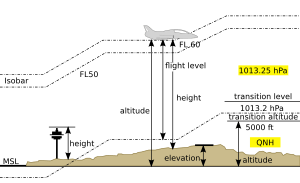Altitude facts for kids
Altitude is a word that means how high something is above a certain point. Think of it as the distance straight up from the ground or from sea level. People use this word a lot when talking about flying, like in aviation (airplanes, parachuting) or when mapping places in geography.
Sometimes, when talking about mountains, people use the word elevation instead of altitude. But mountain climbers often use altitude to describe how high they are and how it affects their bodies. For buildings or other things on the ground, we usually just say their height. If you're talking about how far down something is, like a hole or the bottom of the ocean, you'd use the word depth.
Contents
Altitude in Flying and Space
When airplanes fly, their altitude can be measured in different ways. It can be measured from the average sea level (called Mean Sea Level or MSL) or from the ground directly below them (called Above Ground Level or AGL).
Airplanes often figure out their altitude by using air pressure. The higher you go, the thinner the air gets, and the less pressure it has. An instrument called an altimeter measures this pressure and turns it into a height, usually in feet or metres. It's like a special type of barometer that shows height instead of pressure.
There are different ways to describe altitude in aviation:
- Indicated altitude is what the altimeter shows. It's usually close to the true height above sea level, but it needs to be adjusted for local air pressure.
- True altitude is the actual distance above sea level.
- Absolute altitude is the distance above the ground directly below the aircraft. This is also called Above Ground Level (AGL).
- Height can also mean the distance above a specific point on the ground. Radio altimeters measure this type of height.
- Pressure altitude is measured using a standard air pressure. This is important for how aircraft perform.
- Density altitude considers how thick or thin the air is. This depends on things like temperature and humidity. Thinner air (high density altitude) can make it harder for planes to take off, especially on hot days or at high-elevation airports.
Earth's Atmosphere Layers
The Earth's atmosphere is split into several layers based on how high they are. Each layer has different temperatures and air conditions:
- Troposphere: This is the layer closest to Earth, where we live and where most weather happens. It goes from the surface up to about 8,000 meters (5 miles) at the poles and 18,000 meters (11 miles) at the equator.
- Stratosphere: This layer is above the troposphere, reaching up to about 50 kilometers (31 miles). Airplanes often fly here because it's very stable.
- Mesosphere: Above the stratosphere, this layer goes up to about 85 kilometers (53 miles).
- Thermosphere: This layer extends from the mesosphere up to about 675 kilometers (419 miles).
- Exosphere: This is the very outer layer of Earth's atmosphere, fading into space, reaching up to about 10,000 kilometers (6,200 miles).
High Altitude and Thin Air
When we talk about places on Earth or in the atmosphere that are far above sea level, we call them high altitude areas. High altitude is often considered to start at about 2,400 meters (8,000 feet) above sea level.
At high altitudes, the atmospheric pressure is lower. This means there's less air pushing down. This happens because of gravity (which pulls air closer to the ground) and the heat in the air (which makes air molecules spread out). So, most of the air stays closer to sea level, making the air thinner the higher you go.
Because the air expands and cools as it rises, high-altitude places are usually cold. This creates a special alpine climate that affects the plants and animals living there.
How High Altitude Affects Humans
Altitudes above 1,500 meters (5,000 feet) can start to affect humans. People generally cannot live permanently at very high altitudes above 5,500-6,000 meters (18,000-20,000 feet). The lower air pressure at high altitudes means there's less oxygen to breathe. This can cause altitude sickness, which might include headaches, dizziness, and feeling tired. More serious problems can include fluid in the lungs or brain.
The human body can adjust to high altitudes over time. It does this by breathing faster, having a higher heart rate, and making more red blood cells to carry oxygen. This process, called acclimatization, can take days or weeks. It helps people who live in high mountains and mountain climbers.
However, if people go to very high altitudes quickly, like pilots, they might need special equipment like a space suit or a pressurized airplane cabin to keep the air pressure normal. Above 8,000 meters (26,000 feet), the human body struggles to adapt and can eventually die. This is why climbers on the world's tallest mountains often carry oxygen tanks and only stay at the very highest points for a few hours.
Images for kids
-
A Boeing 737-800 cruising in the stratosphere, where airliners typically cruise to avoid turbulence rampant in the troposphere. The blue layer is the ozone layer, fading further to the mesosphere. The ozone heats the stratosphere, making conditions stable. The stratosphere is also the altitude limit of jet aircraft and weather balloons, as the air density there is roughly 1⁄1000 of that in the troposphere.
See also
 In Spanish: Altitud para niños
In Spanish: Altitud para niños



